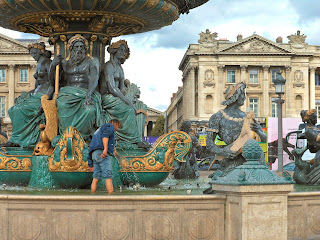To reach Oradour-sur-Glane we first wound through a memorial museum dedicated to documenting and remembering the events of the fateful night and to preserving the remains of the town. Squinting at the small English subtexts on the displays, we learned that on June 10th, 1944, a team of about 200 German Waffen-SS soldiers raided the town while everyone was gathered in the central square and separated the men from the women and children. The men were divided into small groups and trapped in burning garages while they were barraged with gunfire. The women and youth were led to the church, of all places, which was set on fire and also showered in bullets. When the genocide was over, five men, one woman, and not a single child had managed to escape. 642 people were murdered during the one-day massacre.
 |
| A moving quote in the memorial museum |
Today, the charred remains of the town have been preserved almost exactly as they were left that day as a memorial to those lost, while a second Oradour-sur-Glane was built adjacent to the ruins in the 1950s. Amazingly, there is still no universally accepted theory on the motivations behind the attack, but you can read about the politics and events leading up to it
here and
here.
We would never have known about this place if it hadn't been for our hosts. This is not somewhere you see (nor should see) in tourist brochures. It is frozen in time by the death and destruction that occurred there nearly 70 years ago, and you can't experience it without being infused with a deep appreciation for the simple privilege of being alive, that we so naturally take for granted each day but that is denied to too many. Bastien and Lucie say they are outraged at how so many people could die for absolutely nothing, but if those people could see an American couple and a French couple walking together today through the site of their last hours; mourning, remembering, and learning from others' errors; they might find some peace.
We asked the museum curators and our hosts if taking photos was appropriate; they all said it was okay. Something just didn't feel quite right to me about it, but if they are used in a respectful way for the purposes of spreading awareness, honoring the deceased, and attempting to prevent such brutality in the future, then I think that's perfectly acceptable. What do you think?















